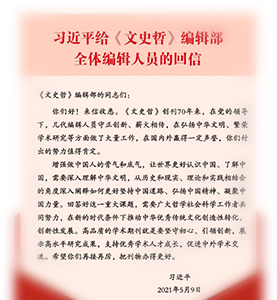陈寅恪的文史之学——从1932年清华大学国文入学试题谈起
陆 扬
摘要:1932年8月清华大学入学考试,陈寅恪以对对子作为国文考试题引发争议,他本人也在事后提出完整的“对对子”理论,指出对对子可以测试考生四种能力,尤其其中第四种能力,即思想能力,在陈寅恪看来是能否创造出最高境界的对子的关键所在,他用黑格尔逻辑中的“正反合”之说来说明。对于这一争议的意义,当代学界有诸多分析,但对于陈寅恪的对对子观中代表对对子最高境界的所谓“正反合”之说的涵义,以及具体试题如“孙行者”如何体现这种“正反合”之说,则缺乏讨论。对这一问题的考察不仅可以帮助我们更精确把握陈寅恪文史之学的特点,也使我们认识到陈寅恪在清华国文考试前后的学术转型的意义。推动此转型的一个重要因素是胡适的学术研究对陈寅恪的影响,尤其是胡适佛教史方面的研究,催生了陈寅恪的诸多学术篇章,并且在方法论的层次上也刺激陈寅恪更递进一步。陈氏对《西游记》和禅宗的研究与胡适的同类研究有密切关系,可能是促使他在国文对子试题中将“孙行者”与“胡适之”联系起来的内在因缘。“孙行者”和“胡适之”这一对子实际是带有敬意的游戏。相较于胡适着重做禅宗历史的史实层面的证伪工作,陈寅恪更注意禅宗等佛教思想概念演变的内在轨迹及其与中古思想社会的关联。在共同纠正“整理国故”实践以真伪评判价值的偏颇上,陈寅恪对冯友兰的《中国哲学史》的理路颇为推许。陈寅恪对对子说和他的文史之学直接相关。他重视骈俪,主要并不在于其绮丽的语言表现形式,而在于骈俪文字能通过巧妙用典等手段呈现出沟通古今的历史意识,延展人的想象空间,以及特殊的感染力。但要真正能做到这一点,作者需要有独立的思想。在这个意义上,对对子是通往那些目标的一个步骤。独立的思想和通过用典等古典语言体现的叙事力和想象力,恰恰也是构筑不朽史学的三种必备条件,可以说它们就是陈寅恪文史之学的精髓。
Chen Yinke’s Scholarship of Classical Chinese Literature: Starting from the Entrance Exam of Tsinghua University in 1932
Lu Yang
Abstract: In August 1932, Chen Yinke (also Chen Yinkoh) was invited to design the Chinese entrance exam for the Westernized Tsinghua University. He surprised the public by adopting traditional duiduizi (“making antithetical couplets”) as a key component of the exam. Inclusion of examples like Sun Xingzhe (a nick name of Sun Wukong, the Monkey King from Xiyouji) among the list of duizi questions was particularly controversial. In Chen’s own elaboration on the rationale behind his inclusion of duiduizi, he pointed to their ability to test students’ competence in four different skill sets: knowledge of parts of speech, tonality, vocabulary and the ability to think. While the first three are stylistic characteristics of parallel structured duizi, it is the fourth quality that sets the stage for a truly competent response, one in which the two antithetical parts are matched grammatically and connected in substance, together creating a unified poetic imagery or coherent narrative. This process, according to Chen, resembled the three stages of thesis, antithesis, and synthesis in Hegelian logic. In his final years of life, Chen revealed that his intended match for Sun Xingzhe was Hu Shizhi (the studio name of Hu Shih), the leading figure of the New Cultural Movement and a friend of Chen. While current scholarship has focused on this controversy and Chen’s theory on duiduizi from the perspectives of the cultural war among early 20th century Chinese intellectuals and Chen’s cultural conservatism, no serious attempt has been made to explain how Chen’s theory of duiduizi, especially the rule of creating a synthesis, can be applied to the actual duizi used in the exam, especially Sun Xingzhe. Why does the matching of Sun Xingzhe with Hu Shizhi create a synthesis beyond its playful parallelism? This is no small matter because an investigation in this direction helps us to understand Chen Yinke’s unique perspective on parallelism in classical Chinese writing. It also leads us to appreciate his scholarly transition in the beginning of the 1930s from a philological approach to Central Asian and Chinese translations of Buddhist texts to a more disciplinary approach in his study of the culture, religion and history of medieval China. Chen’s intended match of Sun Xingzhe with Hu Shizhi in fact paid intellectual tribute to Hu Shi, whose study of Xiyouji had inspired Chen’s own investigation of this classical fantasy novel. During this period Chen’s scholarship responded to and competed with that of Hu Shih, especially in the field of medieval Chinese Buddhism. In contrast to Hu Shih’s concentrated efforts to eradicate fictitious elements in Chan historiography, Chen focused more on tracing its conceptual development within medieval Chinese Buddhism and identifying intellectual linkages between Buddhism and medieval Chinese culture. Methodologically Chen also became critical of the “Re-arranging the national heritage” (zhengli guogu) movement led by Hu Shih. He shared Feng Youlan’s view that the intellectual and historical value of ancient text cannot be assessed solely on the basis of authorship. Chen’s view of the value of duiduizi also highlights his unique understanding of the significance of parallel style writing in classical Chinese literature. For Chen, the real charm of parallel style literature, whether poetry or prose, did not lie in its resplendent form, but in its creative use of allusion and classical precedents within the literary framework of parallelism. It could construct a historic vision that connected past with present, stimulated imagination, and, last but not the least, carried emotional power of persuasion. Achieving its full potential however required that writer have independent minds and free spirits. In this sense, duiduizi was no different. His valuing duiduizi thus echoes his views on the essence of Chinese humanistic tradition and great historical writing, both of which similarly demonstrated independent thinking, historical imagination, and narrative skill.


